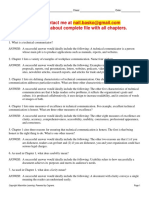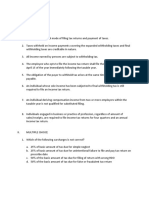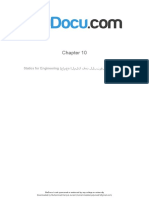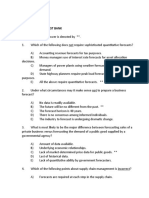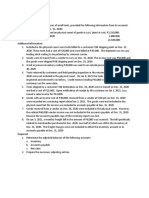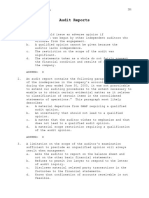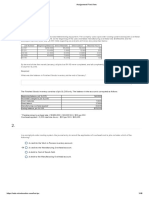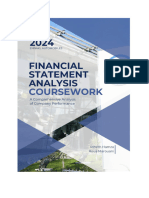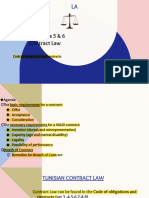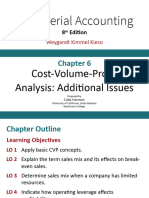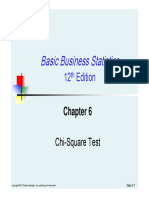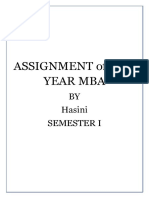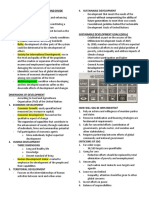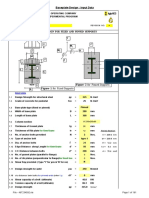Chapter 5 Inflation TEST BANK 1
Chapter 5 Inflation TEST BANK 1
Uploaded by
Marouani RouaCopyright:
Available Formats
Chapter 5 Inflation TEST BANK 1
Chapter 5 Inflation TEST BANK 1
Uploaded by
Marouani RouaOriginal Title
Copyright
Available Formats
Share this document
Did you find this document useful?
Is this content inappropriate?
Copyright:
Available Formats
Chapter 5 Inflation TEST BANK 1
Chapter 5 Inflation TEST BANK 1
Uploaded by
Marouani RouaCopyright:
Available Formats
lOMoARcPSD|33480594
Chapter 5 Inflation- Its Causes, Effects, and Social Costs
Macroeconomía (Universidad Carlos III de Madrid)
Studocu is not sponsored or endorsed by any college or university
Downloaded by Yassine BenArbia (yassinect2k20@gmail.com)
lOMoARcPSD|33480594
1. The rate of inflation is the:
A) median level of prices.
B) average level of prices.
C) percentage change in the level of prices.
D) measure of the overall level of prices.
2. The definition of the transactions velocity of money is:
A) money multiplied by prices divided by transactions.
B) transactions divided by prices multiplied by money.
C) money divided by prices multiplied by transactions.
D) prices multiplied by transactions divided by money.
3. If there are 100 transactions in a year and the average value of each transaction is $10,
then if there is $200 of money in the economy, transactions velocity is ______ times per
year.
A) 0.2
B) 2
C) 5
D) 10
4. If the transactions velocity of money remains constant while the quantity of money
doubles, the:
A) price of the average transaction must double.
B) number of transactions must remain constant.
C) price of the average transaction multiplied by the number of transactions must
remain constant.
D) price of the average transaction multiplied by the number of transactions must
double.
5. Real money balances equal the:
A) sum of coin, currency, and balances in checking accounts.
B) amount of money expressed in terms of the quantity of goods and services it can
purchase.
C) number of dollars used as a medium of exchange.
D) quantity of money created by the Federal Reserve.
Page 1
Downloaded by Yassine BenArbia (yassinect2k20@gmail.com)
lOMoARcPSD|33480594
6. If the average price of goods and services in the economy equals $10 and the quantity of
money in the economy equals $200,000, then real balances in the economy equal:
A) 10.
B) 20,000.
C) 200,000.
D) 2,000,000.
7. The demand for real money balances is generally assumed to:
A) be exogenous.
B) be constant.
C) increase as real income increases.
D) decrease as real income increases.
8. If the quantity of real money balances is kY, where k is a constant, then velocity is:
A) k.
B) 1/k.
C) kP.
D) P/k.
9. If the demand for real money balances is proportional to real income, velocity will:
A) increase as income increases.
B) increase as income decreases.
C) vary directly with the interest rate.
D) be constant.
10. Given that M / P = kY, when the demand for money parameter, k, is large, the velocity
of money is ______, and money is changing hands ______.
A) large; frequently
B) large; infrequently
C) small; frequently
D) small; infrequently
11. Consider the money demand function that takes the form M / P = kY, where M is the
quantity of money, P is the price level, k is a constant, and Y is real output. If the money
supply is growing at a 10 percent rate, real output is growing at a 3 percent rate, and k is
constant, what is the average inflation rate in this economy?
A) 3 percent
B) 7 percent
C) 10 percent
D) 13 percent
Page 2
Downloaded by Yassine BenArbia (yassinect2k20@gmail.com)
lOMoARcPSD|33480594
12. When people want to hold _____ money, the income velocity of money increases, and
the money demand parameter k ______ .
A) more; increases
B) less; increases
C) more; decreases
D) less; decreases
13. The quantity theory of money assumes that:
A) income is constant.
B) velocity is constant.
C) prices are constant.
D) the money supply is constant.
14. If income velocity is assumed to be constant, but no other assumptions are made, the
level of ______ is determined by M.
A) prices
B) real GDP
C) transactions
D) nominal GDP
15. If velocity is constant and, in addition, the factors of production and the production
function determine real GDP, then:
A) the price level is proportional to the money supply.
B) real GDP is proportional to the money supply.
C) the price level is fixed.
D) nominal GDP is fixed.
16. In the long run, according to the quantity theory of money and classical macroeconomic
theory, if velocity is constant, then ______ determines real GDP and ______ determines
nominal GDP.
A) the productive capability of the economy; the money supply
B) the money supply; the productive capability of the economy
C) velocity; the money supply
D) the money supply; velocity
Page 3
Downloaded by Yassine BenArbia (yassinect2k20@gmail.com)
lOMoARcPSD|33480594
17. According to the quantity theory of money, ultimate control over the rate of inflation in
the United States is exercised by:
A) the Organization of the Petroleum Exporting Countries (OPEC).
B) the U.S. Treasury.
C) the Federal Reserve.
D) private citizens.
18. According to the quantity theory of money, if money is growing at a 10 percent rate and
real output is growing at a 3 percent rate, but velocity is growing at increasingly faster
rates over time as a result of financial innovation, the rate of inflation must be:
A) increasing.
B) decreasing.
C) 7 percent.
D) constant.
19. If the money supply increases 12 percent, velocity decreases 4 percent, and the price
level increases 5 percent, then the change in real GDP must be ______ percent.
A) 3
B) 4
C) 9
D) 11
20. Percentage change in P is approximately equal to the percentage change in:
A) M.
B) M minus the percentage change in Y.
C) M minus the percentage change in Y plus the percentage change in velocity.
D) M minus the percentage change in Y minus the percentage change in velocity.
21. Using average rates of money growth and inflation in the United States over many
decades, Friedman and Schwartz found that decades of high money growth tended to
have ______ rates of inflation and decades of low money growth tended to have ______
rates of inflation.
A) high; high
B) high; low
C) low; low
D) low; high
Page 4
Downloaded by Yassine BenArbia (yassinect2k20@gmail.com)
lOMoARcPSD|33480594
22. The right of seigniorage is the right to:
A) levy taxes on the public.
B) borrow money from the public.
C) draft citizens into the armed forces.
D) print money.
23. “Inflation tax” means that:
A) as the price level rises, taxpayers are pushed into higher tax brackets.
B) as the price level rises, the real value of money held by the public decreases.
C) as taxes increase, the rate of inflation also increases.
D) in a hyperinflation, the chief source of tax revenue is often the printing of money.
24. The inflation tax is paid:
A) only by the central bank.
B) by all holders of money.
C) only by government bond holders.
D) equally by every household.
25. The real interest rate is equal to the:
A) amount of interest that a lender actually receives when making a loan.
B) nominal interest rate plus the inflation rate.
C) nominal interest rate minus the inflation rate.
D) nominal interest rate.
26. If the nominal interest rate is 1 percent and the inflation rate is 5 percent, the real
interest rate is:
A) 1 percent.
B) 6 percent.
C) –4 percent.
D) –5 percent.
27. If the real interest rate declines by 1 percent and the inflation rate increases by 2 percent,
the nominal interest rate implied by the Fisher equation:
A) increases by 2 percent.
B) increases by 1 percent.
C) remains constant.
D) decreases by 1 percent.
Page 5
Downloaded by Yassine BenArbia (yassinect2k20@gmail.com)
lOMoARcPSD|33480594
28. If the real interest rate and real national income are constant, according to the quantity
theory and the Fisher effect, a 1 percent increase in money growth will lead to rises in:
A) inflation of 1 percent and the nominal interest rate of less than 1 percent.
B) inflation of 1 percent and the nominal interest rate of 1 percent.
C) inflation of 1 percent and the nominal interest rate of more than 1 percent.
D) both inflation and the nominal interest rate of less than 1 percent.
29. According to the quantity theory of money, a 5 percent increase in money growth
increases inflation by ___ percent. According to the Fisher equation, a 5 percent
increase in the rate of inflation increases the nominal interest rate by ____ percent.
A) 1; 5
B) 5; 1
C) 1; 1
D) 5; 5
30. According to the quantity theory of money and the Fisher equation, if the money growth
increases by 3 percent and the real interest rate equals 2 percent, then the nominal
interest rate will increase:
A) 2 percent.
B) 3 percent.
C) 5 percent.
D) 6 percent.
31. In the classical model, according to the quantity theory of money and the Fisher
equation, an increase in money growth increases:
A) output.
B) velocity.
C) the nominal interest rate.
D) the real interest rate.
32. Evidence from the past 40 years in the United States supports the Fisher effect and
shows that when the inflation rate is high, the ______ interest rate tends to be ______.
A) nominal; high
B) nominal; low
C) real; high
D) real; low
Page 6
Downloaded by Yassine BenArbia (yassinect2k20@gmail.com)
lOMoARcPSD|33480594
33. The ex ante real interest rate is equal to the nominal interest rate:
A) minus the inflation rate.
B) plus the inflation rate.
C) minus the expected inflation rate.
D) plus the expected inflation rate.
34. When a person purchases a 90-day Treasury bill, he or she cannot know the:
A) ex post real interest rate.
B) ex ante real interest rate.
C) nominal interest rate.
D) expected rate of inflation.
35. Equilibrium in the market for goods and services determines the ______ interest rate,
and the expected rate of inflation determines the ______ interest rate.
A) ex ante real; ex ante nominal
B) ex post real; ex post nominal
C) ex ante nominal; ex post real
D) ex post nominal; ex post real
36. The ex ante real interest rate is based on _____ inflation, while the ex post real interest
rate is based on _____ inflation.
A) expected; actual
B) core; actual
C) actual; expected
D) expected; core
37. The ex post real interest rate will be greater than the ex ante real interest rate when the:
A) rate of inflation is increasing.
B) rate of inflation is decreasing.
C) actual rate of inflation is greater than the expected rate of inflation.
D) actual rate of inflation is less than the expected rate of inflation.
38. The opportunity cost of holding money is the:
A) nominal interest rate.
B) real interest rate.
C) federal funds rate.
D) prevailing Treasury bill rate.
Page 7
Downloaded by Yassine BenArbia (yassinect2k20@gmail.com)
lOMoARcPSD|33480594
39. The real return on holding money is
A) the real interest rate.
B) minus the real interest rate.
C) the inflation rate.
D) minus the inflation rate.
40. If the real return on government bonds is 3 percent and the expected rate of inflation is 4
percent, then the cost of holding money is ______ percent.
A) 1
B) 3
C) 4
D) 7
41. In its most general formulation, the demand function for real balances depends on the
level of income and the:
A) real interest rate.
B) nominal interest rate.
C) rate of inflation.
D) price level.
42. If the nominal interest rate increases, then:
A) the money supply increases.
B) the money supply decreases.
C) the demand for money increases.
D) the demand for money decreases.
43. Consider the money demand function that takes the form (M / P)d = Y / (4i), where M is
the quantity of money, P is the price level, Y is real output, and i is the nominal interest
rate. What is the average velocity of money in this economy?
A) i
B) 4
C) 1 / (4i)
D) 0.25
44. If the Fed announces that it will raise the money supply in the future but does not
change the money supply today,
A) both the nominal interest rate and the current price level will decrease.
B) the nominal interest rate will increase and the current price level will decrease.
C) the nominal interest rate will decrease and the current price level will increase.
D) both the nominal interest rate and the current price level will increase.
Page 8
Downloaded by Yassine BenArbia (yassinect2k20@gmail.com)
lOMoARcPSD|33480594
45. If the money supply is held constant, then an increase in the nominal interest rate will
______ the demand for money and ______ the price level.
A) increase; increase
B) increase; decrease
C) decrease; increase
D) decrease; decrease
46. If the demand for money depends on the nominal interest rate, then via the quantity
theory and the Fisher equation, the price level depends on:
A) only the current money supply.
B) only the expected future money supply.
C) both the current and expected future money supply.
D) neither the current nor the expected future money supply.
47. According to the classical theory of money, reducing inflation will not make workers
richer because firms will increase product prices ______ each year and give workers
______ raises.
A) more; larger
B) more; smaller
C) less; larger
D) less; smaller
48. According to the classical theory of money, inflation does not make workers poorer
because wages increase:
A) faster than the overall price level.
B) more slowly than the overall price level.
C) in proportion to the increase in the overall price level.
D) in real terms during periods of inflation.
49. The inconvenience associated with reducing money holdings to avoid the inflation tax is
called:
A) menu costs.
B) shoeleather costs.
C) variable yardstick costs.
D) fixed costs.
Page 9
Downloaded by Yassine BenArbia (yassinect2k20@gmail.com)
lOMoARcPSD|33480594
50. The costs of reprinting catalogs and price lists because of inflation are called:
A) menu costs.
B) shoeleather costs.
C) variable yardstick costs.
D) fixed costs.
51. Inflation ______ the variability of relative prices and ______ the efficiency of the
allocation of resources.
A) increases; increases
B) increases; decreases
C) decreases; decreases
D) decreases; increases
52. In the case of an unanticipated increase in inflation:
A) creditors with an unindexed contract are hurt because they get less than they
expected in real terms.
B) creditors with an indexed contract gain because they get more than they contracted
for in nominal terms.
C) debtors with an unindexed contract do not gain because they pay exactly what they
contracted for in nominal terms.
D) debtors with an indexed contract are hurt because they pay more than they
contracted for in nominal terms.
53. The costs of unexpected inflation, but not of expected inflation, are:
A) menu costs.
B) the arbitrary redistribution of wealth between debtors and creditors.
C) unintended distortions of individual tax liabilities.
D) the costs of relative price variability.
54. If inflation was 6 percent last year and a worker received a 4 percent nominal wage
increase last year, then the worker's real wage:
A) increased 4 percent.
B) increased 2 percent.
C) decreased 2 percent.
D) decreased 6 percent.
Page 10
Downloaded by Yassine BenArbia (yassinect2k20@gmail.com)
lOMoARcPSD|33480594
55. If nominal wages cannot be cut, then the only way to reduce real wages is by:
A) adjustments via inflation.
B) unions.
C) legislation.
D) productivity increases.
56. A rate of inflation that exceeds 50 percent per month is typically referred to as a:
A) conflagration.
B) hyperinflation.
C) deflation.
D) disinflation.
57. Hyperinflations ultimately are the result of excessive growth rates of the money supply;
the underlying motive for the excessive money growth rates is frequently a
government's:
A) desire to increase prices throughout the economy.
B) need to generate revenue to pay for spending.
C) responsibility to increase nominal interest rates by increasing expected inflation.
D) inability to buy government securities through open-market operations.
58. Which of the following would most likely be called a hyperinflation?
A) Price increases averaged 300 percent per year.
B) The inflation rate was 10 percent per year.
C) Real GDP grew at a rate of 12 percent over a year.
D) A stock market index rose by 1,000 points over a year.
59. During a hyperinflation, real tax revenue of the government often drops substantially
because of the:
A) delay between when a tax is levied and when it is collected.
B) significantly greater menu costs of printing tax forms.
C) additional deductions taken for increased shoeleather costs.
D) greater uncertainty associated with extreme rates of inflation.
60. The major source of government revenue in most countries that are experiencing
hyperinflation is:
A) customs duties.
B) income taxes.
C) seigniorage.
D) borrowing.
Page 11
Downloaded by Yassine BenArbia (yassinect2k20@gmail.com)
lOMoARcPSD|33480594
61. To end a hyperinflation, a government trying to reduce its reliance on seigniorage
would:
A) print more money.
B) raise taxes and cut spending.
C) lower taxes and increase spending.
D) lower interest rates.
62. Most hyperinflations end with _____ reforms that eliminate the need for _____.
A) monetary; taxes
B) monetary; currency
C) fiscal; seigniorage
D) fiscal; currency
63. Which of the following is an example of a relative price?
A) the real interest rate
B) the capital stock
C) the dollar wage per hour
D) the price level
64. Variables expressed in terms of physical units or quantities are called ______ variables.
A) real
B) nominal
C) endogenous
D) exogenous
65. Variables expressed in terms of money are called ______ variables.
A) real
B) nominal
C) endogenous
D) exogenous
66. An example of a real variable is the:
A) dollar wage a person earns.
B) quantity of goods produced in a year.
C) price level.
D) nominal interest rate.
Page 12
Downloaded by Yassine BenArbia (yassinect2k20@gmail.com)
lOMoARcPSD|33480594
67. An example of a nominal variable is the:
A) money supply.
B) quantity of goods produced in a year.
C) relative price of bread.
D) real wage.
68. The classical dichotomy:
A) cannot hold if money is “neutral.”
B) is said to hold when the values of real variables can be determined without any
reference to nominal variables or the existence of money.
C) fully describes the world in which we live, especially in the short run.
D) arises because money depends on the nominal interest rate.
69. According to the classical dichotomy, when the money supply decreases, _____ will
decrease.
A) real GDP
B) consumption spending
C) the price level
D) investment spending
70. The concept of monetary neutrality in the classical model means that an increase in the
money supply growth rate will increase:
A) real GDP.
B) real interest rates.
C) nominal interest rates.
D) both saving and investment by the same amount.
71. The characteristic of the classical model that the money supply does not affect real
variables is called:
A) the monetary basis.
B) monetary policy.
C) the quantity theory of money.
D) monetary neutrality.
72. The theoretical separation of real and monetary variables is called:
A) the classical dichotomy.
B) monetary neutrality.
C) the Fisher effect.
D) the quantity theory of money.
Page 13
Downloaded by Yassine BenArbia (yassinect2k20@gmail.com)
lOMoARcPSD|33480594
73. A small country might want to use the money of a large country rather than print its own
money if the small country:
A) is likely to be unstable, whereas the large country is likely to be stable.
B) is likely to be stable, whereas the large country is likely to be unstable.
C) needs the revenue for seigniorage.
D) wants to control its own inflation rate.
74. If consumption depends positively on the level of real balances, and real balances
depend negatively on the nominal interest rate, then:
A) the classical dichotomy still holds.
B) a rise in money growth leads to a fall in consumption and a rise in investment.
C) a rise in money growth leads to a rise in consumption and a fall in investment.
D) a rise in money growth leads to a rise in both consumption and investment.
75. If consumption depends positively on the level of real balances and real balances
depend negatively on the nominal interest rate, then the nominal interest rate:
A) declines when the money growth rate rises.
B) is unchanged when the money growth rate rises.
C) rises 1 percent for each 1 percent rise in the money growth rate.
D) rises less than 1 percent for each 1 percent rise in the money growth rate.
76. Assume that a series of inflation rates is 1 percent, 2 percent, and 4 percent, while
nominal interest rates in the same three periods are 5 percent, 5 percent, and 6 percent,
respectively.
a. What are the ex post real interest rates in the same three periods?
b. If the expected inflation rate in each period is the realized inflation rate in the previous
period, what are the ex ante real interest rates in periods 2 and 3?
c. If someone lends in period 2, based on the ex ante inflation expectation in part b, will he or
she be pleasantly or unpleasantly surprised in period 3 when the loan is repaid?
Page 14
Downloaded by Yassine BenArbia (yassinect2k20@gmail.com)
lOMoARcPSD|33480594
77. Mary Tsai is paid $3,000 every 30 days. Her salary is deposited directly in her bank.
She spends all her money at a constant rate over the 30 days and must pay cash. She can
(1) withdraw all of the money at once; (2) withdraw half at once and the rest after 15
days; (3) withdraw one-third at once, one-third after 10 days, and one-third at 20 days;
or (4) make any number of evenly spaced withdrawals. Each withdrawal costs her $2 in
terms of time and inconvenience. For each day that Mary has a dollar in the bank, she
gets .03 cents (.0003 per dollar) in interest. Thus, if she withdraws half of her money
immediately and half in 15 days, she has $1,500 in the bank for 15 days and earns $6.75
interest.
a. Create a table showing transaction costs, interest earned, and total net earnings (+) or cost (–)
associated with one, two, three, or four withdrawals per month.
b. How many withdrawals per month lead to the largest net earnings? If Mary chooses this
number, what will be her average amount of cash on hand over the 30 days?
78. Assume that the demand for real money balance (M / P) is M / P = 0.6Y – 100i, where Y
is national income, and i is the nominal interest rate (in percent). The real interest rate r
is fixed at 3 percent by the investment and saving functions. The expected inflation rate
equals the rate of nominal money growth.
a. If Y is 1,000, M is 100, and the growth rate of nominal money is 1 percent, what must i and P
be?
b. If Y is 1,000, M is 100, and the growth rate of nominal money is 2 percent, what must i and P
be?
79. Econoland finances government expenditures with an inflation tax.
a. Explain who pays the tax and how it is paid.
b. What are the costs associated with an inflation tax?
80. If the demand for money depends positively on real income and depends inversely on
the nominal interest rate, what will happen to the price level today if the central bank
announces (and people believe) that it will decrease the money growth rate in the future,
but it does not change the money supply today?
81. Although “inflation is always and everywhere a monetary phenomenon,” explain why:
a. the start of a hyperinflation is typically related to the fiscal policy situation.
b. the end of a hyperinflation is usually related to changes in fiscal policy.
Page 15
Downloaded by Yassine BenArbia (yassinect2k20@gmail.com)
lOMoARcPSD|33480594
82. Consider two countries, Hitech and Lotech. In Hitech new arrangements for making
payments, such as credit cards and ATMs, have been enthusiastically adopted by the
population, thereby reducing the proportion of income that is held as real money
balances. Over this period no such changes occurred in Lotech. If the rate of money
growth and the growth rate of real GDP were the same in Hitech and Lotech over this
period, then how would the rate of inflation differ between the two countries? Carefully
explain your answer.
83. Interest rates played a part in the 1984 U.S. presidential debates. Some politicians
claimed that interest rates rose over the 1981–1983 period, while others claimed rates
fell. Below is a table showing interest rates and annual inflation rates from 1981 to
1983.
Interest Rate Annual
Year (annual %) Inflation Rate
1981 14.03% 10.3%
1982 10.69% 6.2%
1983 8.63% 3.2%
Reconcile these conflicting claims.
84. The costs of expected inflation cause productive resources of an economy to be
expended on adjusting to changing prices. Explain how each of the following costs of
expected inflation distort the allocation of productive resources:
a. shoeleather costs
b. menu costs
85. Assume an economy where only burgers are traded. In a year, 100 burgers are traded at
the rate of $5 per burger. Assume two scenarios:
a. The economy has $100 in the form of 20 $5 bills.
b. The economy has $100 in the form of 100 $1 bills.
Calculate the velocity of money for both situations.
86. For a country A, the GDP growth rate is 8 percent and inflation is 4 percent. If the
velocity of money remains constant, what is the change in real money balances?
87. Suppose a government has a tax revenue shortfall. Will hyperinflation inevitably follow
unless the government cuts its fiscal expenditures?
Page 16
Downloaded by Yassine BenArbia (yassinect2k20@gmail.com)
lOMoARcPSD|33480594
88. If there are no unexpected changes in money supply in an economy, can there still be
unexpected inflation in the economy?
Page 17
Downloaded by Yassine BenArbia (yassinect2k20@gmail.com)
lOMoARcPSD|33480594
Answer Key
1. C
2. D
3. C
4. D
5. B
6. B
7. C
8. B
9. D
10. D
11. B
12. D
13. B
14. D
15. A
16. A
17. C
18. A
19. A
20. C
21. B
22. D
23. B
24. B
25. C
26. C
27. B
28. B
29. D
30. C
31. C
32. A
33. C
34. A
35. A
36. A
37. D
38. A
39. D
40. D
41. B
42. D
43. B
44. D
Page 18
Downloaded by Yassine BenArbia (yassinect2k20@gmail.com)
lOMoARcPSD|33480594
45. C
46. C
47. D
48. C
49. B
50. A
51. B
52. A
53. B
54. C
55. A
56. B
57. B
58. A
59. A
60. C
61. B
62. C
63. A
64. A
65. B
66. B
67. A
68. B
69. C
70. C
71. D
72. A
73. A
74. B
75. D
76.
77.
78.
79.
80.
81.
82.
83.
84.
85.
86.
87.
88.
Page 19
Downloaded by Yassine BenArbia (yassinect2k20@gmail.com)
You might also like
- Chapter 03 Test Bank - Version1Document31 pagesChapter 03 Test Bank - Version1lizarrdoNo ratings yet
- Test Bank For Technical Communication, 13e Mike Markel, Stuart Selber Test BankDocument8 pagesTest Bank For Technical Communication, 13e Mike Markel, Stuart Selber Test BankNail Basko0% (1)
- Afar 17Document19 pagesAfar 17Ivhy Cruz EstrellaNo ratings yet
- Macroeconomics Test Bank Chapter 8 9Document58 pagesMacroeconomics Test Bank Chapter 8 9ანთეა აბრამიშვილი100% (2)
- Final Examination - TaxationDocument9 pagesFinal Examination - TaxationCatherine Lavadia100% (1)
- CH1 HbotbDocument7 pagesCH1 HbotbJela OasinNo ratings yet
- A Pocket Guide To PEFCDocument8 pagesA Pocket Guide To PEFCPEFC UK Ltd.No ratings yet
- Swot Matrix - AMANDocument1 pageSwot Matrix - AMANmedai lehNo ratings yet
- Chap 20 Test Bank Test BankDocument41 pagesChap 20 Test Bank Test BankVũ Hồng PhươngNo ratings yet
- Cpar1-Financialaccountingandreporting: Multiple Choice QuestionsDocument8 pagesCpar1-Financialaccountingandreporting: Multiple Choice Questionstankofdoom 4No ratings yet
- Quiz - AISDocument2 pagesQuiz - AISALMA MORENANo ratings yet
- Chapter 1 Managerial Accounting, The Business Organization, and Professional EthicsDocument36 pagesChapter 1 Managerial Accounting, The Business Organization, and Professional Ethicssamah100% (1)
- Practice Questions On Fiscal PolicyDocument5 pagesPractice Questions On Fiscal PolicyJaime SánchezNo ratings yet
- FIN203 Tutorial 1 QDocument4 pagesFIN203 Tutorial 1 Q黄于绮100% (1)
- Chapter-10 - Test BankDocument14 pagesChapter-10 - Test Bankwasif ahmedNo ratings yet
- Chapter 05 - Discrete Probability Distributions: F (X) 1 For All Values of X F (X) 0 For All Values of XDocument25 pagesChapter 05 - Discrete Probability Distributions: F (X) 1 For All Values of X F (X) 0 For All Values of XRedNo ratings yet
- Chapter1 2Document6 pagesChapter1 2Young Joo MoonNo ratings yet
- Chapter 3 - Consolidations - Subsequent To The Date of AcquisitionDocument79 pagesChapter 3 - Consolidations - Subsequent To The Date of AcquisitionBLe BerNo ratings yet
- Finance MCQDocument27 pagesFinance MCQravi kangneNo ratings yet
- MAS Quiz BeeDocument37 pagesMAS Quiz BeeRose Gwenn VillanuevaNo ratings yet
- Chapter 6 Questions & AnswersDocument3 pagesChapter 6 Questions & AnswersPRATEEK SHARMANo ratings yet
- Test Bank Chapter 1 The Demand For Audit and Other Assurance Services Test Bank Chapter 1 The Demand For Audit and Other Assurance ServicesDocument16 pagesTest Bank Chapter 1 The Demand For Audit and Other Assurance Services Test Bank Chapter 1 The Demand For Audit and Other Assurance ServicesDalia ElarabyNo ratings yet
- Ifrs 5 Acca AnswersDocument2 pagesIfrs 5 Acca AnswersMonirul Islam MoniirrNo ratings yet
- An Overview of Financial Management: Multiple Choice: ConceptualDocument15 pagesAn Overview of Financial Management: Multiple Choice: ConceptualJully GonzalesNo ratings yet
- Multiple Choice Test BankDocument10 pagesMultiple Choice Test BankSoumitra Chakraborty100% (1)
- Prelim Financial Management - Midterm Exam With SolutionDocument6 pagesPrelim Financial Management - Midterm Exam With Solutionchristian Reyes100% (1)
- International Marketing Chapter 9Document5 pagesInternational Marketing Chapter 9HCCNo ratings yet
- Sample Problems in Markov Analysis PDFDocument4 pagesSample Problems in Markov Analysis PDFAysenur ErdoganNo ratings yet
- Kayranto Development Economics II Review QuestionsDocument19 pagesKayranto Development Economics II Review Questionsmenurmohamed71No ratings yet
- Effects of Errors 2021Document2 pagesEffects of Errors 2021Ali SwizzleNo ratings yet
- CH - 2 For TeacherDocument11 pagesCH - 2 For TeacherEbsa AdemeNo ratings yet
- Chapter 01 - Test Bank: Multiple Choice QuestionsDocument48 pagesChapter 01 - Test Bank: Multiple Choice QuestionsW11No ratings yet
- Auditing Theory - 100Q: Audit Report CMPDocument10 pagesAuditing Theory - 100Q: Audit Report CMPMaria PauNo ratings yet
- 004 +Self+Test,+Financial+ForecastingDocument15 pages004 +Self+Test,+Financial+ForecastingMatel Franklin AnastaNo ratings yet
- Mas 9000 EconomicsDocument10 pagesMas 9000 EconomicsAljur SalamedaNo ratings yet
- Audit Reports Test BankDocument24 pagesAudit Reports Test Bankrandomlungs121223No ratings yet
- 4 - Conceptual Framework: Elements of Financial StatementsDocument7 pages4 - Conceptual Framework: Elements of Financial Statementsagm25No ratings yet
- Macro Economics XII MCQs/One Mark Questions With AnswersDocument6 pagesMacro Economics XII MCQs/One Mark Questions With AnswersMeenakshiNo ratings yet
- Investment Mid ExamDocument4 pagesInvestment Mid Examende workuNo ratings yet
- 5Document46 pages5Navindra JaggernauthNo ratings yet
- Macroeconomics Money Market MCQsDocument3 pagesMacroeconomics Money Market MCQsTan NguyenNo ratings yet
- Chapter 5 - Time Value of Money Multiple Choice QuestionsDocument35 pagesChapter 5 - Time Value of Money Multiple Choice QuestionsNagaeshwary Murugan100% (2)
- Multiple-Choice QuestionsDocument7 pagesMultiple-Choice QuestionsEych MendozaNo ratings yet
- CE Government Accounting PDFDocument9 pagesCE Government Accounting PDFjtNo ratings yet
- MAS CPAR - EconomicsDocument7 pagesMAS CPAR - EconomicsJulie Ann LeynesNo ratings yet
- National Income Accounting PPT MBADocument58 pagesNational Income Accounting PPT MBARhea Mae Caramonte AmitNo ratings yet
- ME Lecture5Document33 pagesME Lecture5Song YueNo ratings yet
- EPS and DPSDocument3 pagesEPS and DPSJaehyunnssNo ratings yet
- Auditing Theory 3rd ExaminationDocument12 pagesAuditing Theory 3rd ExaminationKathleenNo ratings yet
- Chapter 3-Evaluation of Financial Performance: Multiple ChoiceDocument23 pagesChapter 3-Evaluation of Financial Performance: Multiple ChoiceKyla Ramos DiamsayNo ratings yet
- Aau ModelDocument34 pagesAau ModelTayech TayuNo ratings yet
- Chapter 15 Q and A PDFDocument37 pagesChapter 15 Q and A PDFNanon WiwatwongthornNo ratings yet
- Got Acctg Rie PDF FreeDocument118 pagesGot Acctg Rie PDF FreeBrian Torres100% (1)
- Test Development Economics by Yasir KarimDocument14 pagesTest Development Economics by Yasir KarimShabana ShboNo ratings yet
- Chapter 5Document19 pagesChapter 5pcnp46x7brNo ratings yet
- 5Document26 pages5Kevin HaoNo ratings yet
- Chapter 5 ReviewDocument7 pagesChapter 5 ReviewZahaAliNo ratings yet
- Chapter 4 and 5 - For StudentsDocument6 pagesChapter 4 and 5 - For Studentsdesada testNo ratings yet
- Macroeconomics 9th Edition Mankiw Test Bank 1Document20 pagesMacroeconomics 9th Edition Mankiw Test Bank 1tinacunninghamadtcegyrxz100% (41)
- Demand For Money - Part 1Document5 pagesDemand For Money - Part 1nickngaok2906No ratings yet
- PQ 2 (Ch4-6)Document7 pagesPQ 2 (Ch4-6)KuangogoNo ratings yet
- 總經第5章作業練習Document3 pages總經第5章作業練習dutexlove3No ratings yet
- FSA COURSEWORK (1) (1)Document19 pagesFSA COURSEWORK (1) (1)Marouani RouaNo ratings yet
- 4- DCF Valuation (Blank)Document8 pages4- DCF Valuation (Blank)Marouani RouaNo ratings yet
- Chap 5 Contract LawDocument32 pagesChap 5 Contract LawMarouani RouaNo ratings yet
- ch06 - CVP Analysis Additional IssuesDocument70 pagesch06 - CVP Analysis Additional IssuesMarouani RouaNo ratings yet
- Chapter 6 1Document69 pagesChapter 6 1Marouani RouaNo ratings yet
- (Ebooks PDF) Download Memoirs of Roads Calcutta From Colonial Urbanization To Global Modernization 1st Edition Sumanta Banerjee Full ChaptersDocument84 pages(Ebooks PDF) Download Memoirs of Roads Calcutta From Colonial Urbanization To Global Modernization 1st Edition Sumanta Banerjee Full Chaptersshrimjudale100% (2)
- Rhombus Energy v. CirDocument15 pagesRhombus Energy v. CirSteven TylerNo ratings yet
- East Delhi Municipal Corporation: E-Mutation of TaxpayerDocument2 pagesEast Delhi Municipal Corporation: E-Mutation of TaxpayerShubham Gupta0% (1)
- 418NMT01 Numerical MethodsDocument2 pages418NMT01 Numerical MethodsSunil KumarNo ratings yet
- Depositos y Creditos Abr-Mar 2024-1Document3 pagesDepositos y Creditos Abr-Mar 2024-1leaxoxo.smNo ratings yet
- Macleods Sales 16Document1 pageMacleods Sales 16Dharmendra GaurNo ratings yet
- Philippines As An Emerging Market: Mentor - Dr. Shalini TiwariDocument10 pagesPhilippines As An Emerging Market: Mentor - Dr. Shalini TiwariRahul ChauhanNo ratings yet
- Thesis StatementDocument3 pagesThesis StatementARNOLDNo ratings yet
- Memo Administrative SanctionsDocument9 pagesMemo Administrative SanctionsBrian PaulNo ratings yet
- Master Thesis Critical Success Factors oDocument183 pagesMaster Thesis Critical Success Factors oHassenNo ratings yet
- PDF 4697270 InvoiceDocument2 pagesPDF 4697270 InvoiceAmis2018 Amis2018No ratings yet
- International Business Reading Materials-FinalDocument11 pagesInternational Business Reading Materials-FinalNardsdel RiveraNo ratings yet
- AnswerDocument16 pagesAnswerhasini83% (6)
- Macro Econ CH 10Document42 pagesMacro Econ CH 10maria37066100% (1)
- TCWDocument11 pagesTCWEstelle Theresa GulayNo ratings yet
- Elephant by Raymond CarverDocument11 pagesElephant by Raymond CarverFaisal JahangeerNo ratings yet
- Verifiable Form Criteria Quantifiable Information Subjective InformationDocument5 pagesVerifiable Form Criteria Quantifiable Information Subjective InformationAnonymous BwN1AVNo ratings yet
- Design of Base PlateDocument161 pagesDesign of Base PlatemaheshbandhamNo ratings yet
- Tax Book Part PDFDocument128 pagesTax Book Part PDFTimothy WilliamsNo ratings yet
- Contruction Labor Contract Tess BasayaDocument4 pagesContruction Labor Contract Tess BasayaEppie SeverinoNo ratings yet
- IBM - MCQ BankDocument12 pagesIBM - MCQ BankNarvada Shankar SinghNo ratings yet
- Sagilah A/P Panirselvam: Mailing and Information'SDocument4 pagesSagilah A/P Panirselvam: Mailing and Information'SDevagi TamilselvanNo ratings yet
- Agusan Colleges, Inc.: Butuan CityDocument4 pagesAgusan Colleges, Inc.: Butuan CityCRestine Joy Elmido MonteroNo ratings yet
- On Rationomics: An Analysis Into The Workings of A Bit Torrent Tracker's Economy and It's CompositionDocument9 pagesOn Rationomics: An Analysis Into The Workings of A Bit Torrent Tracker's Economy and It's CompositionPorc UpeneNo ratings yet
- Syria Construction Sector : Market StructureDocument1 pageSyria Construction Sector : Market Structurejaga67No ratings yet
- 516-Article Text-8816-2-10-20230331Document17 pages516-Article Text-8816-2-10-20230331vivi irsamNo ratings yet
- Saft-Sble SBM SBH en 22153-2-0123Document11 pagesSaft-Sble SBM SBH en 22153-2-0123Muhamad YasrinNo ratings yet
- The Indian Partnership Act, 1932Document23 pagesThe Indian Partnership Act, 1932Deborah100% (5)

